#pattern drafting tutorial
Explore tagged Tumblr posts
Text
Babydoll Shoulder Straps: How to Draft and Sew
In this post, you’ll discover how to self draft and sew babydoll shoulder straps. Love what you see ? Support me by snagging some cool items from my shop! Every purchase helps me bring you more awesome content. Thank you! Shop Now Are you looking to add a delicate, custom touch to your sewing projects? Babydoll shoulder straps are a perfect addition to any garment, offering both style and…
#Babydoll shoulder straps#Custom garment straps#DIY Sewing Projects#easy sewing patterns#Fashion design patterns#Home Sewing Projects#How to draft a sewing pattern#How to sew shoulder straps#pattern drafting tutorial#Sewing Techniques for Beginners#sewing tips and tricks#Sewing Tutorial for Beginners#step-by-step sewing guide
4 notes
·
View notes
Note
hihi! first off, I absolutely LOVE your artstyle lol
would you have any tips on how to draw rosettes? I’ve been practicing drawing markings for a while now but I still can’t get it to look round/circle-ish yet natural lmao
Thank you! and Rosettes are weird lil guys haha; here's how I do them!:
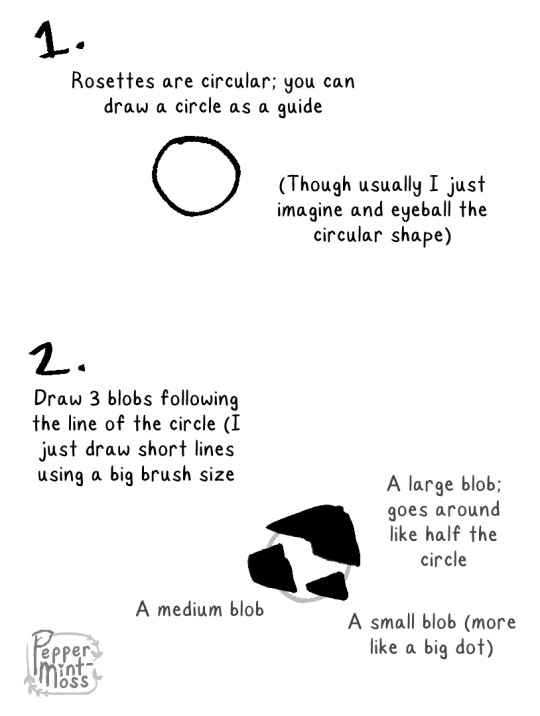
Rosettes come in a lot of varieties though! Some rosettes have more or less blobs, or sometimes they're just solid dots/blobs. 3 blobs just makes a good example for a tutorial because it shows how the blobs follow a circle shape
And by "cirular" i mean anything from a perfect circle, to a wide oval, to a rounded rectangle or triangle lol (leopard photo below from unsplash)


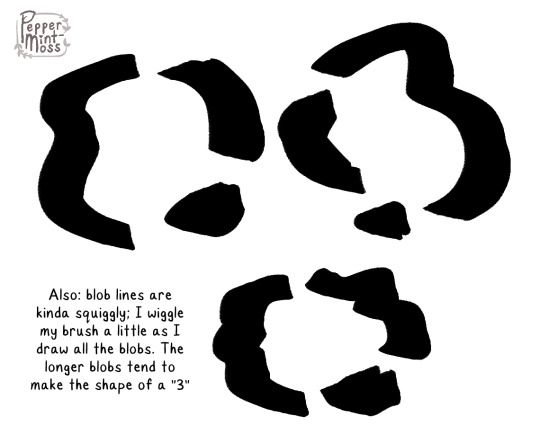
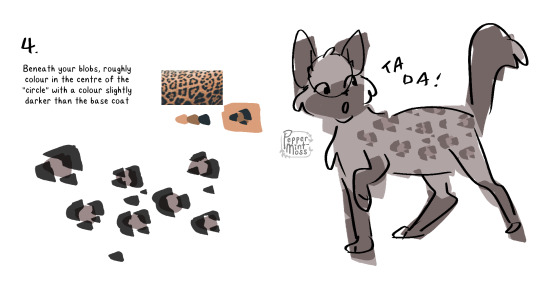
You could actually probably do step 4 first, and use that 'inner circle' as your circular guideline for your blobs! I prefer doing my blob lines first though so I can space each rosette out how I like (vs doing the inner circle first and later realizing that with the blob lines the rosettes are too close together)
I used my typical triangle brush because I use it for everything But a circular brush looks more realistic I think:
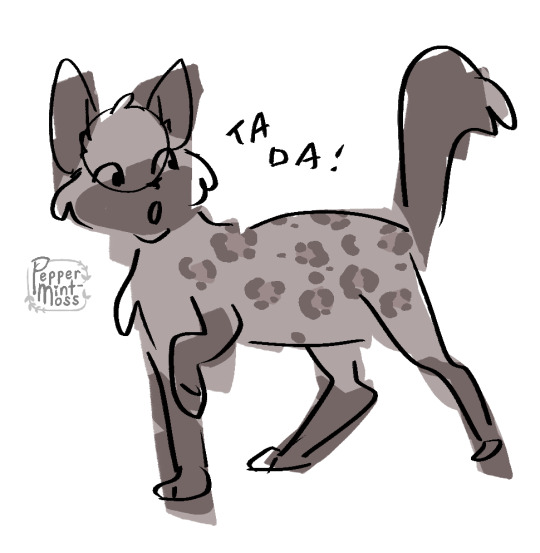
Hope that helps!
commission info || ko-fi (tip jar)
#tutorial#art tutorial#rosettes#cats#leopard#coat pattern#cat#ppmpost#anon#had this ask sitting in my drafts for a while cause I felt like I didn't really know how to draw em either#than realized I literally have a method to it and have drawn em before and think they look fine on those previous pieces#idk its something about rosettes that make me unconfident haha orz#i draw 1 and im like thats fuckin nothing and then i draw 20 more and only then im like oh yeah that looks like rosettes
95 notes
·
View notes
Video
youtube
Learn Pattern Drafting for Beginners: Make a Wrap Skirt That Fits YOU!
2 notes
·
View notes
Text
Can You Learn to Sew Online? A Comprehensive Look at Your Options with ONSA
At ONSA - Online Sewing Academy, the world of stitching and garment construction should be accessible to everyone, regardless of location or schedule. In today's digital age, online learning has revolutionized how we acquire new skills, making it possible to master intricate crafts like sewing from the comfort of our homes. But can you truly become an expert stitcher through virtual classes alone? Let's explore the options available and how ONSA empowers you to embark on an enriching sewing journey.
The Beauty of Pre-Recorded Video Lessons
Ah, the world of pre-recorded tutorials - a treasure trove of knowledge at your fingertips! ONSA's extensive library of meticulously crafted video lessons offers a comprehensive exploration of sewing techniques, from the fundamentals of threading a needle to the intricacies of advanced garment construction. One of the most significant advantages of this format is the ability to learn at your own pace, rewinding and revisiting lessons as many times as needed until each stitch and seam becomes second nature.
Our pre-recorded videos are thoughtfully designed to cater to diverse learning styles, combining visual demonstrations with clear, concise explanations. Whether you're a visual learner who thrives on observing each step or an auditory learner who appreciates detailed verbal guidance, our lessons ensure that no aspect of the sewing process is left unexplained.
While budget-friendly and convenient, we understand that pre-recorded content may lack the human interaction that many pupils crave – the ability to ask questions, receive real-time feedback, and benefit from the personalized attention of an experienced instructor. This is where our live, interactive classes come into play.
The Magic of Live, Interactive Classes
Imagine having a seasoned ONSA instructor by your virtual side, guiding you through the intricate sewing world with patience and expertise. Our live, online classes provide an immersive, interactive experience replicating the intimacy of a physical classroom setting. Through video conferencing technology, you can follow along with your instructor, ask questions as they arise, and receive real-time feedback on your technique.
One of the most significant advantages of live classes at ONSA is the ability to learn at a pace that suits your individual needs. Our instructors are adept at adapting their teaching methods to accommodate varying skill levels, ensuring that every student feels included and supported. Whether you're a complete novice taking your first tentative stitches or a skilled stitcher seeking to elevate your art, our talented teachers can customize lesson plans to align with your unique goals and aspirations.
From mastering the art of inserting invisible zippers to acquiring advanced draping skills for haute couture designs, our live classes cover various topics, catering to hobbyists and aspiring professionals. Private one-on-one sessions and small group workshops provide ample opportunity for personalized guidance, fostering an environment where questions are welcomed, and challenges are addressed with patience and expertise.
The ONSA Edge: A Holistic Approach to Sewing Education
At ONSA, we understand that sewing is more than just a practical skill – it's an art form that combines technical precision with creative expression. Our approach to online sewing education is rooted in this philosophy, nurturing both the technical and artistic aspects of this timeless craft.
Our team of expert instructors, each with years of industry experience and a passion for teaching, has thoughtfully crafted a multifaceted curriculum that covers the entire spectrum of sewing, from understanding fabric properties and pattern drafting to mastering advanced construction techniques and exploring fashion design principles.
By combining our comprehensive library of pre-recorded video resources with live, interactive sessions, ONSA provides a 360-degree learning experience tailored to your schedule, skillset, and aspirations. Whether you prefer the convenience of self-paced learning or thrive on the dynamic energy of a virtual classroom, our blend of educational formats ensures that your sewing journey is enriching, engaging, and tailored to your unique needs.
Beyond the technical aspects of sewing, ONSA also emphasizes the importance of nurturing creativity and self-expression. Our lessons encourage students to experiment with fabric choices, color combinations, and design elements, fostering an environment where individuality is celebrated and personal style is cultivated.
Sewing Mastery: A Journey, Not a Destination
At ONSA, we firmly believe that sewing mastery is a lifelong pursuit, a continuous learning and refinement journey. Our online academy is designed to support you at every stage of this journey, from your first tentative stitches to the creation of intricate, couture-worthy garments.
As you progress through our curriculum, you can participate in virtual sewing circles, where you can connect with fellow stitchers, share your creations, and seek inspiration from a community of like-minded individuals. Our instructors are not just teachers but mentors dedicated to your growth and success, offering guidance and encouragement every step of the way.
Sewing is more than just a hobby – it's a powerful form of self-expression, transforming fabric into wearable art that reflects your unique style and personality. At ONSA, we strive to empower you to unleash your creativity, one stitch at a time, by providing a comprehensive and immersive online learning experience tailored to your needs.
Ready to Start Stitching Your Dreams into Reality?
Whether you're a busy professional seeking a creative outlet, a stay-at-home parent looking to explore a new passion, or a lifelong stitcher yearning to elevate your skills, ONSA - Online Sewing Academy supports your sewing journey.
Explore our diverse online sewing courses today, from beginner-friendly introductions to advanced masterclasses, and unlock a world of possibilities that transcends time and space. With ONSA, the art of sewing is no longer limited by your location or schedule – it's a vibrant, accessible realm where your dreams can be woven into reality, one exquisite thread at a time.
Join our virtual community of passionate stitchers, where inspiration, camaraderie, and personal growth intertwine seamlessly. Embark on a transformative journey that will teach you sewing techniques, ignite your creativity, boost your confidence, and empower you to express your individuality through the timeless art of garment construction.
The world of sewing awaits, and at ONSA, we're committed to being your trusted guide every step of the way. Unleash your inner stitching prowess, and let your creativity take flight – the possibilities are endless.
#sewing#sewing classes#online sewing classes#learn to sew online#virtual sewing lessons#sewing tutorials#pre-recorded sewing videos#live sewing classes#interactive sewing instruction#ONSA sewing academy#sewing education#sewing mastery#garment construction#fashion design#pattern drafting#sewing techniques#creative sewing#sewing community#sewing journey#sewing skills#beginner sewing#advanced sewing#couture sewing#self-paced learning#personalized instruction#sewing mentorship#sewing creativity#sewing expression#wearable art#fabric art
15 notes
·
View notes
Text
youtube
My latest video is live!
Happy Pride Month!
#pride#LGBTQ#LGBTQIA#sewing#sewing tutorial#skirt#how to sew a skirt#sew a skirt with pockets#rainbow#sew#do it yourself#circle skirt#sewing drafting#sewing pattern#clothing#diy#Youtube
16 notes
·
View notes
Text
This author is achieving precisely the type of success I strive for.
slightly losing my mind over this bookmark
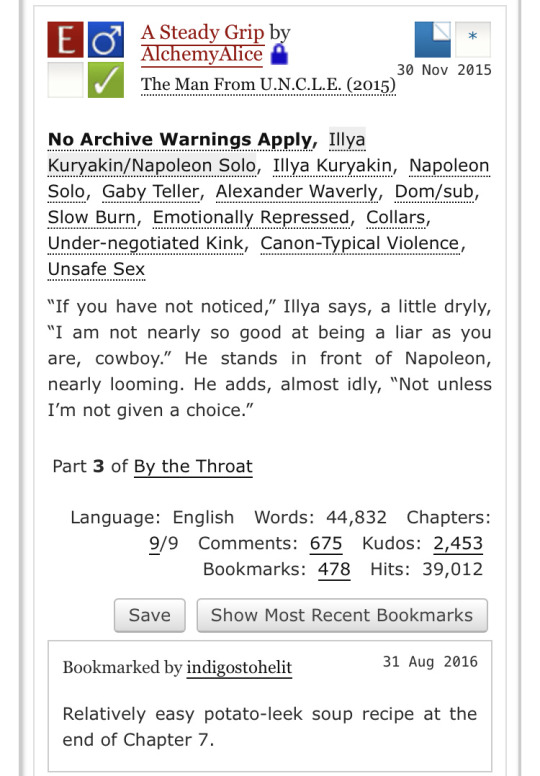
#if anyone put up with me rambling about Geralt’s ass long enough to read the associated pattern-drafting tutorials#then I’ve done well
22K notes
·
View notes
Text
Need to rant for a minute because even though I have very much been enjoying the fruits of my efforts learning how to sew vintage style clothes, I just swapped out old fatphobia (nice plus size vintage clothes never making it to stores) for new fatphobia (trying to find patterns). Cause it doesn't end at what clothes you're able to buy already made.
I finally bought a Friday Pattern Company pattern the other day, and man it made the bare minimum feel like I was being spoiled. The sizes go up to 7X (that's XL, XXL, 1X, 2X, etc, so there's 9 sizes above L) they had a thin and a fat model on the cover! Usually I'm barely lucky enough to get an XL, and I'm just expected to guess how it's going to look on my body. The majority of their patterns have two differently sized models on the covers, and all of them have that full range of patterns inside.
It is so hard to find good plus size patterns, even if they're available, many companies just scale up their mediums and I can't guarantee they're actually sized correctly for a different shape. As good as Friday is, them and other modern indie pattern companies aren't easy to find.
Okay well what if I went another step deeper, what if I forgo patterns all together and decide to be completely independent and draft things myself?
Then I'll need a plus size dress form. I got lucky and found one at an antique mall for 50$ but these are incredibly rare and more expensive than smaller ones. I'll need to learn how to draft patterns, something that was taught to me on a XS form by my college and nearly every tutorial out there. Drafting close fitting clothes for fat bodies is a completely different skillset, because all that extra fat is much squishier and shifts more. Measuring yourself correctly and getting the shape you're looking for is far more important. Before I even got there I'd need to sketch out what I wanted to make, right? Well the patterning book my family got me only shows you how to draw tall, skinny people. A beginner would have to look up their own drawing references and tutorials because what what supposed to be a super accessible beginner's guide to fashion has decided their body isn't normal enough for the baseline tutorial.
We're expected to be the ones who put in the extra effort. Digging to find the pattern companies that fit our shape and actually prove they can, paying extra in shipping or driving farther to pick them up. Having to search specifically for plus size tutorials for drafting and sketching. It's always treated like it's not part of the beginner's experience to be working with a fat body, that's just going to make people more frustrated and lost and less likely to pursue something they're excited about! Especially if it's in response to already being frustrated about the lack of clothing options.
We need a little positivity to this post so to end on a high note, here's me modeling the blazer I just finished with a shirt I made a couple years ago!
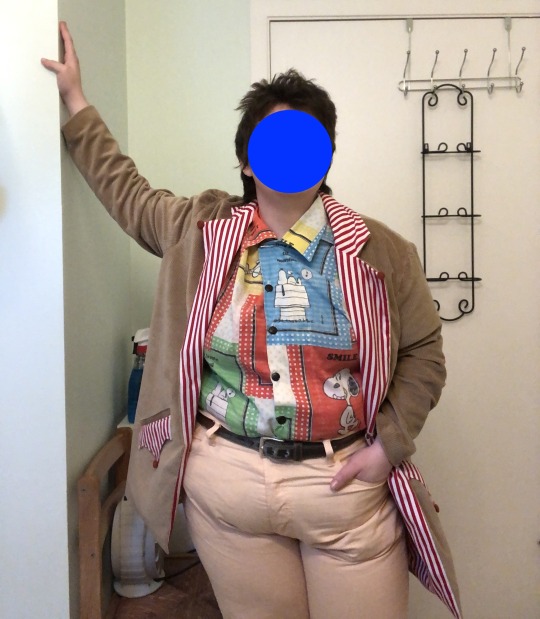
Being able to finally wear clothes I really feel like me in has been an amazing confidence boost. It's not fair that there's so many roadblocks in the way for someone who looks like me who just wants to wear things they enjoy.
#fatshion#cw fatphobia#fatphobia#body posititivity#fat positvity#how the fuck is it hard to find clothes to fit MY body I see people with my body type all the damn time#stay strong out there#fashion#clowncore
2K notes
·
View notes
Text
tbh i've always found sewing patterns uncomfy. there's literally no way they can fit most bodies regardless of how you size them. they rely on people not knowing or not being willing to pattern draft themselves, which is a relatively simple thing to get started with even if it takes a while to perfect (i've been pattern drafting since 2023 and i've made a lot of things that fit me really well - it takes time but it's worth it!). buying patterns requires you to have a printer or be able to print them out, money to buy the pattern, and at least one mockup to adjust the fit, whereas pattern drafting just requires paper, a pencil, a ruler and a measuring tape. you can easily make a bodice block/sloper that you can easily adjust for every new project, but buying new patterns means going through the whole process again and again.
if you want to get started pattern drafting, i suggest watching TheClosetHistorian (all of her projects involve pattern drafting), Minji Lee's bunnysuit series, Mariah Pattie's Secret Formula for Drafting Stays, this tutorial on how to draft a bodice or this one or this one like there is a wealth of information on how to pattern draft please please you can do this you can draft patterns yourself i believe in you
187 notes
·
View notes
Text
Do you sew? Do you have boobs? Do your tops never seem to fit correctly despite following all the instructions on the pattern? THIS IS NOT YOUR FAULT! Sewing patterns usually just tell you to match your full bust measurement to their sizing chart, but this isn't enough information to tell you if the garment will actually fit.
Here's the problem. Imagine three people who all have a 40-inch bust measurement. But one of them is completely flat-chested, one of them is very well-endowed, and the third has the mythical "average" figure that the pattern was designed for. Despite having the same circumference, their torsos are completely different sizes and shapes! So while our lucky "average" sewist can cut out the pattern as written and have it fit, that same size is going to be much too tight in the shoulders for the flat-chested person and much too loose in the shoulders for the buxom one.
And that sucks, because an adjustment to add or remove fullness from the bust is much easier to do than trying to re-size the shoulders and torso. Instead of starting off with the pattern size that matches your bust measurement, it's a lot better if you can start off with the size that fits your shoulders. But almost no patterns tell you how to figure this out!
What you need is to match the high bust measurement. Here's an image (from "Ahead of the Curve: Learn to Fit and Sew Amazing Clothes For Your Curves" by Jenny Rushmore, a GREAT book for learning to fit garments, especially if you're bigger) on how to measure high bust vs full bust.

The difference, in inches, between the full bust measure and the high bust measure is your sewing cup size. (usually not the same as your bra cup size, which is the difference between the full bust measure and the underbust measure. yes, it's confusing. sorry)
So how to use this to figure out what size to cut out from your pattern? If you're using a Big Four sewing pattern, those are all drafted for a B sewing cup, so the high bust for any given size will be two inches less than the given (full) bust measurement. Choose the size that matches your high bust. Then compare the full bust measurement to yours. If it matches, great! If it's smaller or larger, you will have to do either a full bust adjustment or small bust adjustment. They seem scary because they're slash-and-spread adjustments, but if you find a good tutorial they're not that hard. You can also just make a mockup in the pattern size that matches your high bust and either add or remove fabric in the bust area until it behaves.
What if you're not using a Big Four pattern? Well, if you're lucky you'll find a pattern you like from a company that simply provides the high bust measurement as well as the full bust in their chart. A few places, like Cashmerette, actually include multiple cup sizes in their patterns so you don't need to do any math to get a good fit. Otherwise, if the company tells you what cup size they're drafted with, you can figure out the high bust from the full bust: A cup is one inch difference, B is two, C is three etc.
If the pattern company doesn't tell you anything except the full bust measurement, scold them about it. If you have to guess, smaller sizes will most likely be drafted with a B cup. There's a little more variation in plus sizes. Regardless, if you're making a mockup try to get the shoulders and neck fitting properly before you worry too much about the bust.
Now go forth and sew things that actually fit your body!
#sewing#psa because learning about this was a game-changer for me#even though now i'm always annoyed when pattern companies won't tell meeeeee what their high bust measurement is#also idk how comprehensible this is; some of the fit stuff is hard to get your brain around#if this is confusing but you're interested see if your library has Ahead of the Curve; she explains it all better than i can
651 notes
·
View notes
Text
Scandi Pants Pattern Drafting: Tutorial for Beginners
In this post, you will learn how to self draft comfy scandi pants sewing pattern . Are you looking for a fun, beginner-friendly project that will add a comfy, stylish piece to your wardrobe? You’re in the right place! In this tutorial, I’ll show you how to draft your very own Scandi pants pattern from scratch. Whether you’re new to sewing or just want to create a custom pair of cozy,…
#Beginner pants pattern#Comfy fit pants tutorial#DIY clothing patterns#Drafting clothing patterns#Drafting pajama pants#Easy pants pattern drafting#Free pattern making tutorial#How to draft pants pattern#pattern drafting tutorial#Pattern making for beginners#Scandi Pants Pattern#Self-draft sewing patterns#Simple sewing projects
3 notes
·
View notes
Note
I heard you make clothes, is there a specific way to make the patterns? Or do you find them online?
I draft all my own patterns, often based on diagrams of patterns copied from historical garments. I have an old post where I talked a bit about my patterning process, but it definitely won't work for everyone. I did learn to do drafting the "proper" way in college, which gave me a good start at understanding the shapes, but all the basic blocks we made aren't anywhere near the right cut or fit for the 18th century stuff I like to make.
You don't need to go to college to learn basic block drafting though, there are instructions in books and on the internet! You can make a basic block for a bodice, a sleeve, pants and/or a skirt, and once they're fitted to your measurements and you've learned a bit about pattern manipulation you can do many things with them. We used the same basic bodice block as a starting point for both corsets and tailored coats. Just make sure to always do mockups in a cheap fabric.
The Closet Historian has some videos on basic block drafting and dart manipulation and such. She mainly does vintage inspired feminine styles, but in college we did more or less the same dart placement on the basic bodice block wether or not the wearer had boobage. (I'm sure there are lots more tutorials out there too, but I haven't looked them up.)
Getting back to the more historical stuff, I have an old post with a lot of resource links which I keep meaning to make into a better organized post on my blogspot, but there's just so very much of it.
There are places to buy patterns online, but not having bought any of them I can't personally speak on their quality, and also every company has different focuses so it would depend on what you specifically want to sew. I mostly do 18th century menswear, so if I did want to buy patterns my options would be very few and far between.
291 notes
·
View notes
Text
Patternmaking, both basic and creative: The Shapes of Fabric

Once upon a time I used to follow the blog of someone who worked in the fashion industry who would write irate posts on fitting and quality issues, teaching me in the process why ready to wear trousers never fit properly, exactly how to set a sleeve, and why T-shirts sometimes start to turn themselves into corkscrews once you've washed them. I'm pretty sure this is not that blog, but I think I found it when I was trying to find the aforementioned one again.
The Shapes of Fabric is a really cool blog with a mix of basic guides like drafting pattern blocks (a base pattern you can use to create more complex garments) and really fun patternmaking experiments that are basically practical geometry.
If you're going to use older sewing sources, it's often really helpful to have at least a basic grasp of what pattern drafting is and how it works, so I'll be linking to some tutorials on how to draft some basic pattern blocks (bearing in mind that I've probably not used this source in particular, but the idea is more or less the same however you explain it):
pattern making basics
how to use basic pattern blocks
bodice block
dartless bodice block
pants block
The site also has a bunch of helpful guides, like these ones:
welt pockets
fitting bodices
fitting pants and skirts
sewing plackets and collars
more on collars
jacket sewing
sewing sleeves
sewing pants
There's also some really cool posts on dart manipulation, flounces, ruffles, "patterns that create patterns" (if you want to go off in a retro futurist way this kind of thing would be neat to incorporate), funky things you can do with sleeves, tucks (v useful if you're into Victorian stuff), detachable collars. Basically, go have a look around and get inspired!
#historical dress reference series#sewing resources#pattern drafting#not strictly historical but very useful#a lot of the techniques they do funky stuff with can be used in a more basic version for vintage and historical fits#i have yet to decide on a posting schedule for this series but i'm procrastinating a sewing project by drafting a few posts for it#so we might as well have this one today#if anyone magically knows what the other blog i'm talking about might be please send it my way#i just logged into my rss reader for the first time in years to see if i have it saved there
82 notes
·
View notes
Text
Self-Drafting Palazzo Pants for Perfect Fit + Video
2 notes
·
View notes
Text
TECHNOBLADE BASE OUTFIT—SHIRT!

WOO YEAH SHIRT TIME let’s all play nice and pretend i didnt make this in like august. thanks


the process was ultimately pretty similar to the pants, just with less dyeing! i drafted a pattern using a tutorial for a bishop sleeve shape on youtube to design the ruffled sleeve, and stitched a half mock-up.


then came assembly which happened in parts due to a fabric quantity snafu… after it was assembled, i added in hand-stitched eyelets for the laces.


the dye job here wasn’t so much an intentional dye job as it was a byproduct of something i needed for another step—tannins. tannins react with iron to create a dark brownish color on fabric, which is a reaction i used on both the shirt and the pants! on the pants, i used straight up iron, while the shirt utilizes a mud dyeing technique from Mali. a fermented mud slurry is watered down and used as a paint effectively, and when let dry entirely and rinsed off it leaves a dark color behind where the mud was applied!


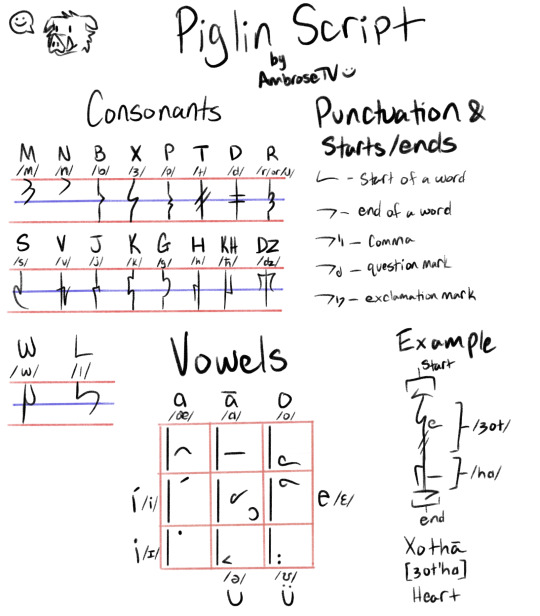
the actual design i used here is a technoblade quote—“one day we’ll look back on where we started, and be amazed by how far we’ve come,” translated into my friend @corpseofsuturedseams’s PIGLIN CONLANG which is FUCKING AWESOME, and then written out in the script it designed to go along with the language!!
ultimately, i didn’t quite let the mud dry completely enough when I went to wash it off and it bled a little, but I really don’t hate the effect that has. I’m super happy with the design as a whole, and with that, the base outfit was done!
next up is the stuff i made for my second critique this semester, which is where things start getting really exciting in my opinion—the head and ‘paws’!!! keep an eye out for those write ups soon*
*soon in the mcyter sense. could mean tomorrow. could mean two months from now. i’ll catch up eventually. maybe.
87 notes
·
View notes
Text
lolita sewing tutorials
i just made an account for reblogging lolita fashion tutorials ! i myself have been struggling to find tutorials - specifically gothic lolita - i found a blog (: @diy-lolita ) but it hasnt been updated since 2015 nd has barely any reblogs loll . .
as someone new to the egl community and fairly new to sewing i still cant just freehand it and i need to know kind of how the patterns look . . .
i will also link some resources there that i didn’t find on tumblr 0.0
+ keep in mind that not everything will be black and look necessarily gothic lolita , moreso stuff you can use black or white colors when making and it will look gothic lolita ! aswell as some tutorials might be more casual but still jfashion inspired , as this is mostly an account for me ! i'm making a post incase other people are actively searching for ways to diy egl fashion and dont know where to start .
the account is @mimisplayground ! ♡︎
i’m going to mention a lot of words under the cut just for reach because i always search for lolita tutorials nd most of them are outdated and inactive TT
gothic lolita sweet lolita ero lolita classic lolita old-school lolita egl community egl sewing lolita sewing diy lolita diy handmade hand-made hand made D.I.Y cute tutorial reblog vault tutorials free patterns pattern easy beginner yamikawaii yamikawa how to make lolita dress drafting pattern draft make pattern resources resource blog active 2025 otome no sewing gothic lolita bible guro lolita scary lolita goth gothic grayscale greyscale doll living doll dress jumperskirt jsk op onepiece mana sama vkei feminine japanese jfashion do it yourself do it at home make at home cutesy kawaii fashion wa lolita qi lolita chinese lolita japanese lolita sewing tutorial slow fashion dupe reblog doll dresses gothic lolitas lita litas egl fashion sew cutsew crochet knit knitting crocheting dark coquette tumblr blogs horror game protagonist brand pieces homemade rare gloomy dollette gloomy coquette dark black and white b&w
#𓏺𓂃𓈒ּ ֶָ֢. ݁ᛪ༙࿐#sad bbydoll#cute blog#morbidette#angels#softette#angelcore#gloomy dollette#mochette#lolita fashion#egl community#handmade#lolita sewing#sewing tutorial#handmade lolita#egl fashion#gothic lolita
27 notes
·
View notes
Note
i am here about the stripey pants.
where/how did you obtain this pattern? the fit & finish are both amazing and I would love to make a similar pair for myself.
I draft all my own patterns, but here's a photo of what this pants pattern looks like. It would be possible to alter a basic pant pattern to have a fall front, and a tutorial for that is on my to-do list, but I won't get to it for quite a long time.


(Ignore the lines on the waistband)
I do have a tutorial for how I machine sew those fall plackets though.

99 notes
·
View notes